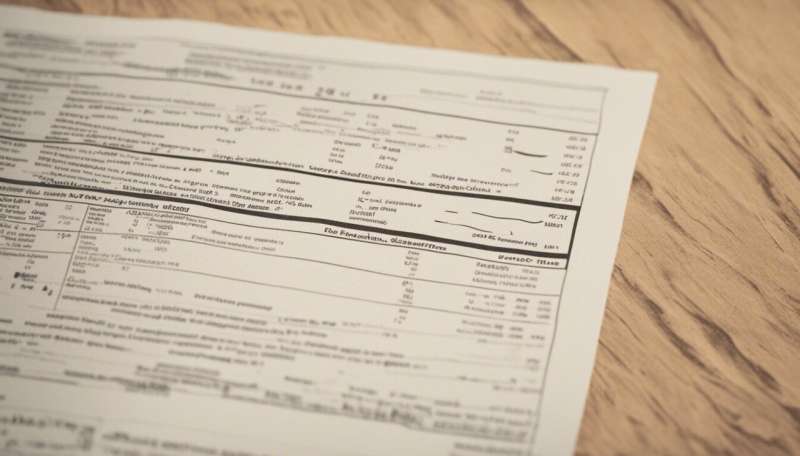Low premiums yet big bills – why high-deductible health plans need reform

A few years ago, we met Angie, a hair salon owner in Oregon with health insurance coverage and a stack of unpaid medical bills. She and her husband were both employed – he as a carpenter—and earned about US$45,000 a year, a bit less than the median income in their county. They were raising two children. Their health insurance had a deductible of US$4,000 for each person, capped at US$8,000 for the family, which meant they had to pay that much before benefits would kick in.
Angie said she had been putting off needed medications for a chronic endocrine disorder and other medical care because they couldn't afford to pay more on top of the US$481 monthly premium. For care she had already gotten, she couldn't afford her portion of the bills – one physician office was suing her family to try to collect.
Angie's situation is far from unique and illustrates an important point about health insurance. While the focus is often on who is getting insurance and what they pay in premiums, how much people pay after the premium receives less attention. These additional out-of-pocket costs can be crucial to whether the plans people buy actually meet their medical needs and help to keep them healthy.
Health insurance isn't black and white
Researchers often treat health insurance as is if it's black and white, or as we call it, a dichotomous variable. Dichotomous variables are data points that can only take one of two values, usually "yes" or "no." Pregnancy is a classic dichotomous variable – you either are or you aren't.
While there's certainly value in analyzing health insurance this way, it is equally important that researchers and others begin to think about coverage as more than just a yes or no question. Health insurance is incredibly nuanced and can vary from almost complete protection from medical costs to leaving people at huge financial risk. To put it simply, it isn't just about whether people have insurance – it's the kind of insurance they have that is critical.
That gets us back to Angie. She had what is known as a high-deductible health plan, which typically has a deductible of US$1,000 or more. These types of plans are now the fastest growing type of health insurance. According to a major survey of employer benefits, nearly one-third of employers will offer only high-deductible plans in 2015, an increase from less than a quarter of employers in 2014. Within the individual market, high-deductible plans are even more prevalent. In the new federal and state health insurance exchanges, 85% of enrollees are in either a silver or bronze level plan, both of which often have deductibles of US$2,000 or more.
The lure of the high-deductible plan
High-deductible plans are attractive because they have a lower monthly premium cost than other types of plans. Sometimes the people who buy them would not be able to afford insurance otherwise. But they often do not provide as much coverage as other plans when people need medical care.
People with chronic disease enrolled in high-deductible plans are more likely to skip medical care than those in traditional plans and more likely to have trouble paying medical bills, studies have found. For example, people with diabetes may forego eye exams that can lessen the chance of complications down the road.
In theory, high-deductible plans could adopt a more flexible benefit design that might perhaps offer more protection for certain medical services. One way to do this is through a value-based insurance design.
Incorporating clinical value into plans
In a value-based insurance design plan, benefits are varied by their level of clinical value, a concept known as clinical nuance. That means that services that have been shown to be important for health are less expensive for enrollees, while those that have not proven effective can have higher out-of-pocket costs. A typical value-based insurance design, for example, would lower or eliminate enrollee costs for services like diabetic eye exams or insulin, which can prevent complications.
But there is an important barrier to adopting this type of design in most high-deductible plans. When these plans are coupled with a tax-exempt health savings account, as they often are, Internal Revenue Service guidelines stipulate that the plans may not cover anything except services strictly meant to detect or prevent disease until the deductible is met. This prevents high-deductible plans from offering value-based insurance design that might control costs and better protect enrollees.
In a recent research project, the University of Michigan's Center for Value-Based Insurance Design partnered with West Health Policy Center, researchers from Harvard Medical School and the University of Minnesota to look at what might happen if high-deductible plans were allowed to adopt a value-based insurance design.
We found that if these plans, called high-value health plans, were allowed to include deductible-exempt coverage for chronic disease services and medications, they would be more expensive up front. Specifically, premiums would rise by about 6% over current high-deductible plans. However, they would likely cover more services without subjecting enrollees to a deductible, perhaps enabling those with chronic disease to better manage their conditions and avoid some of the major medical episodes that can occur when chronic disease is not kept in check. Through a simulation model, we also found the plans would likely be popular on the commercial market, attracting up to 45 million enrollees in both the employer and individual markets.
There's a push now to update the IRS regulations around these types of high-deductible health plans. Lawmakers and policy groups have held hearings, and there's a growing recognition that the current regulations are outdated.
For medical insurance to make a difference to people's health, it must offer meaningful protection. Or, as Angie said, "we don't mind paying for health care, we just wish it would have coverage."
This story is published courtesy of The Conversation (under Creative Commons-Attribution/No derivatives).
![]()


















